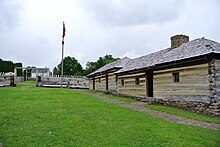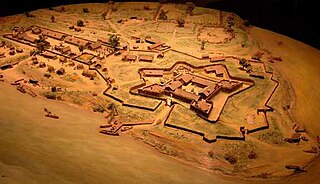
Fort Duquesne was a fort established by the French in 1754, at the confluence of the Allegheny and Monongahela rivers. It was later taken over by the British, and later the Americans, and developed as Pittsburgh in the U.S. state of Pennsylvania. Fort Duquesne was destroyed by the French, prior to British conquest during the Seven Years' War, known as the French and Indian War on the North American front. The British replaced it, building Fort Pitt between 1759 and 1761. The site of both forts is now occupied by Point State Park, where the outlines of the two forts have been laid in brick.

John Forbes was a Scottish professional soldier who served in the British Army from 1729 until his death in 1759.
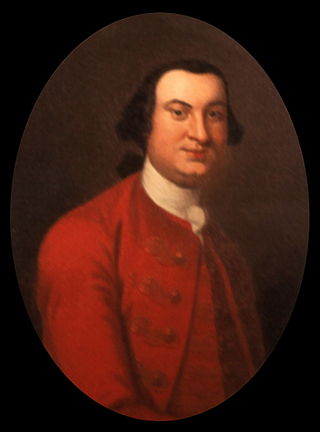
Henry Bouquet was a Swiss mercenary who rose to prominence in British service during the French and Indian War and Pontiac's War. He is best known for his victory over a Native American force at the Battle of Bushy Run, lifting the siege of Fort Pitt during Pontiac's War. During the conflict Bouquet gained lasting infamy in an exchange of letters with his commanding officer, Jeffery Amherst, who suggested a form of biological warfare in the use of blankets infected with smallpox which were to be distributed to Native Americans. Despite this indictment historians have praised Bouquet for leading British forces in several demanding campaigns on the Western Frontier in which they "protected and rescued" settlers from increasingly frequent attacks.
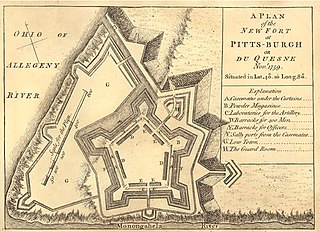
Fort Pitt was a fort built by British forces between 1759 and 1761 during the French and Indian War at the confluence of the Monongahela and Allegheny rivers, where the Ohio River is formed in western Pennsylvania. It was near the site of Fort Duquesne, a French colonial fort built in 1754 as tensions increased between Great Britain and France in both Europe and North America. The French destroyed Fort Duquesne in 1758 when they retreated under British attack.
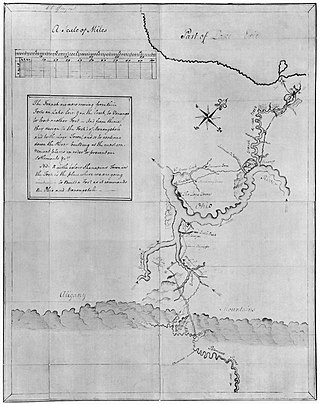
The Battle of Jumonville Glen, also known as the Jumonville affair, was the opening battle of the French and Indian War, fought on May 28, 1754, near present-day Hopwood and Uniontown in Fayette County, Pennsylvania. A company of provincial troops from Virginia under the command of Lieutenant Colonel George Washington, and a small number of Mingo warriors led by the chieftain Tanacharison, ambushed a force of 35 Canadiens under the command of Joseph Coulon de Jumonville.

The Battle of Fort Duquesne was British assault on the eponymous French fort that was repulsed with heavy losses on 14 September 1758, during the French and Indian War.
William Trent was an American fur trader and merchant based in colonial Pennsylvania. He was commissioned as a captain of the Virginia Regiment in the early stages of the French and Indian War, when he served on the western frontier with the young Lt. Colonel George Washington. Trent led an advance group who built forts and improved roads for troop access and defense of the western territory. He was later promoted to the rank of major.
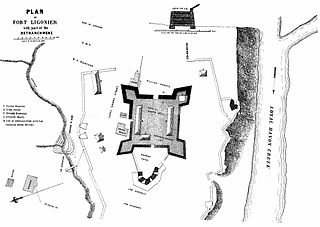
The Battle of Fort Ligonier was a battle of the French and Indian War. On 12 October 1758, French and Indian forces directed from nearby Fort Duquesne were repulsed in an attack on the British outpost of Fort Ligonier, then still under construction.
Fort Bedford was a French and Indian War-era British military fortification located at the present site of Bedford, Pennsylvania. The fort was a star-shaped log fortress erected in the summer of 1758.
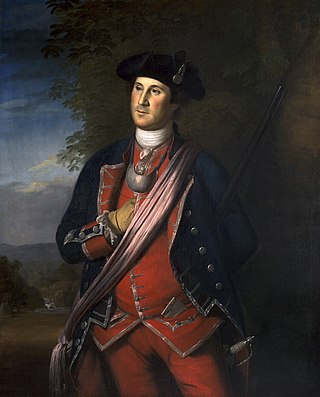
George Washington's military experience began in the French and Indian War with a commission as a major in the militia of the British Province of Virginia. In 1753 Washington was sent as an ambassador from the British crown to the French officials and Indians as far north as present-day Erie, Pennsylvania. The following year he led another expedition to the area to assist in the construction of a fort at present-day Pittsburgh, Pennsylvania. Before reaching that point, he and some of his men, along with Mingo allies led by Tanacharison, ambushed a French scouting party. Its leader was killed, although the exact circumstances of his death were disputed. This peacetime act of aggression is seen as one of the first military steps leading to the global Seven Years' War. The French responded by attacking fortifications Washington erected following the ambush, forcing his surrender. Released on parole, Washington and his troops returned to Virginia.
Ligonier Valley is a valley in Westmoreland County, Pennsylvania, United States.

James Burd was a colonial American soldier in the French and Indian War, during which he played an important role in fortifying the Pennsylvania frontier.

The Forbes Expedition was a British military expedition to capture Fort Duquesne, led by Brigadier-General John Forbes in 1758, during the French and Indian War. While advancing to the fort, the expedition built the now historic trail, the Forbes Road. The Treaty of Easton served to cause a loss of Native American support for the French, resulting in the French destroying the fort before the expedition could arrive on November 24.
François-Marie Le Marchand de Lignery was a colonial military leader in the French province of Canada. Active in the defense of New France during the Seven Years' War, he died of wounds sustained in the 1759 Battle of La Belle-Famille.
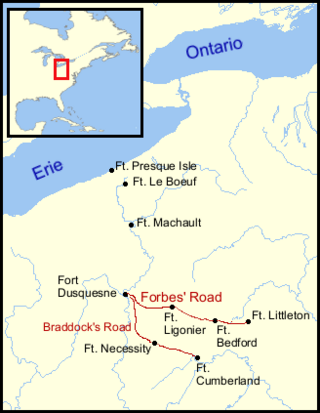
The Forbes Road, a historic military roadway in what was then British America, was initially completed in 1758 from Carlisle, Pennsylvania, to the French Fort Duquesne at the junction of the Allegheny and Monongahela rivers in what is now downtown Pittsburgh, via Fort Loudon, Fort Littleton, Fort Bedford and Fort Ligonier. The road, initially about 220 miles long, was named for Brigadier General John Forbes, the commander of the 1758 British-led expedition that built the road during the French and Indian War. The Forbes Road and Braddock's Road were the two main land routes that the British cut west through the wilderness during the war. The task was complicated by the Appalachian Mountains' steep northeast-to-southwest ridges, a generally broken terrain between the ridges, heavy forestation, and numerous swamps and rivers.
Fort Juniata Crossing, also known as Fort Juniata or simply Juniata Crossing, was a British French and Indian War era fortification located along the Forbes Road. The fort was located along a strategic ford of the Raystown Branch of the Juniata River about 2.4 miles (3.9 km) west of the current site of Breezewood, Pennsylvania.
William Clapham was an American military officer who participated in the construction of several forts in Pennsylvania during the French and Indian War. He was considered a competent commander in engagements with French troops and Native American warriors, but towards the end of his military career he was unpopular with troops under his command. Following his retirement from the army, he and his family were killed by Lenape warriors on his farm in 1763.

Saucunk or Sawcunk was a town established by the Lenape and Shawnees. It was the site of a Catholic mission and was visited by Conrad Weiser, Christian Frederick Post and George Croghan. Saucunk was abandoned after the Battle of Bushy Run in 1763.

Tamaqua or Tamaque, also known as The Beaver and King Beaver, was a leading man of the Unalachtigo (Turkey) phratry of the Lenape people. Although the Iroquois in 1752 had appointed Shingas chief of the Lenape at the Treaty of Logstown, after the French and Indian War Tamaqua rose in prominence through his active role as peace negotiator, and was acknowledged by many Lenape as their "king" or chief spokesman. He was among the first to hand over English captives at the end of the French and Indian War and was active in peace negotiations at the conclusion of Pontiac's War. By 1758, he was recognized as one of three principal leaders of the Lenape, being the primary spokesman for the western Lenape in the Ohio Country. He founded the town of Tuscarawas, Ohio, in 1756 and died there in 1769 or 1771.
Keekyuscung aka Kickyuscung, Kaquehuston, Kikyuskung, Ketiuscund, Kekeuscund, or Ketiushund, was a Delaware (Lenape) chief. In the 1750s he took part in peace negotiations to end Lenape participation in the French and Indian War. In 1754 he briefly engaged in some spying and smuggled some letters into and out of Fort Duquesne for George Washington. He was sympathetic to the British for many years, but in 1763 he and his son Wolf sided with the French after a failed assassination attempt by Colonel Henry Bouquet. He is known for being one of the Native American leaders that attacked Colonel Bouquet's forces at the Battle of Bushy Run, where Keekyuscung was killed.



